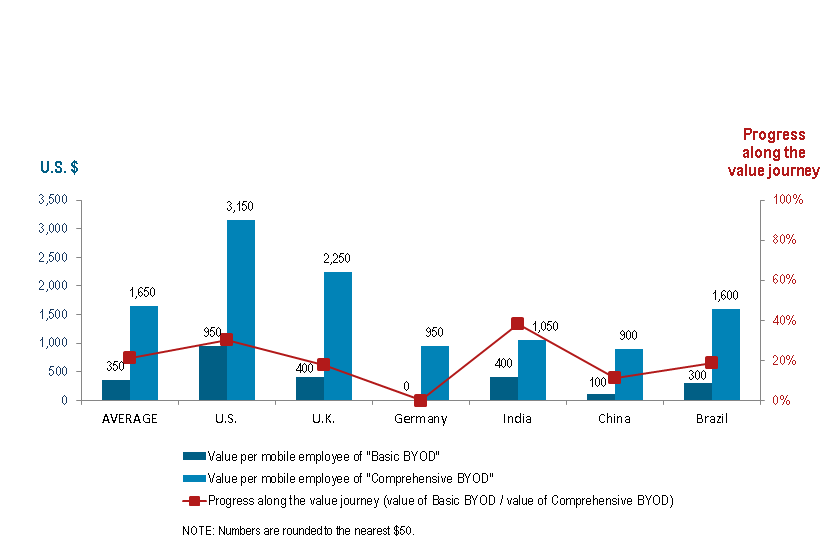The growth of connected devices is impacting enterprises worldwide. The key to unlocking value, however, is shifting from the number of connected devices to the value of the connections themselves. We define a connection as the intersection of People, Process, Data, and Things—coming together to form the Internet of Everything (IoE). The IoE opportunity represents 21 percent of corporate profits, or $14.4 trillion dollars over the next 10 years, worldwide. Capturing the potential value of IoE depends on an inclusive business environment that facilitates innovation and productivity. Fostering a work-your-way environment by empowering employees to bring their own devices is a critical part of the solution.
https://www.youtube.com/watch?v=wwNI9B7Jwxo
There’s no doubt that “bring your own device” (BYOD) is a fast growing global phenomenon, driven by employee demands to use the devices, applications, and cloud services they prefer. BYOD promises tantalizing benefits such as better work-life balance, greater innovation, and improved productivity. Yet some fear that security risks and the complexity of managing so many different personal devices might outweigh the benefits.
New research and analysis released today from the Cisco® Internet Business Solutions Group puts those concerns to rest—showing that not only do companies experience significant value by embracing BYOD today, there is potential for much added benefit.
It’s all about implementation.
An astounding 89 percent of organizations allow their workers to bring their own devices for work. As a result, they are beginning to understand what is needed for successful BYOD—such as secure access, simple authentication, and clear mobility policies. But this is just the starting point. There is a more strategic approach to BYOD that yields even more benefits, from cost savings and productivity gains to critical time efficiencies.
Our vigorous financial analysis of BYOD was conducted across six countries—Brazil, China, Germany, India, the United Kingdom, and the United States. We found that companies in all of these countries are deriving significant value from BYOD today:
- BYOD employees are gaining a global average of 37 minutes of productive time per week. But just as implementation practices vary from country to country, so do benefits.
- The time savings range from 81 minutes per week in the United States to just 4 minutes per week in Germany, where BYOD is viewed more skeptically.
- On average, the current median level of BYOD implementation—what we call “Basic BYOD”—generates $350 of value each year per mobile employee.
- BYOD will continue to grow, with the number of BYOD devices in the countries surveyed expected to more than double, from 198 million in 2013 to 405 million by 2016.
- Smartphones are the overwhelming choice of BYOD employees, who own an average of 1.7 devices for work and have paid $965 in out-of-pocket costs for them.
Not only did we measure the effectiveness and maturity of current BYOD practices, we also wanted to place a value on an ideal BYOD implementation—a concept we call “Comprehensive BYOD”—to see whether a more strategic approach would yield greater benefits. We found that few companies come close to the comprehensive capabilities we outlined. In fact, the average company today is only about 21 percent along the “value journey” to Comprehensive BYOD.
Big Gains, No Matter Where You Start: Annual Value per Mobile Employee for Basic and Comprehensive BYOD Programs

Source: Cisco IBSG, 2013
Regardless of the starting point, we found that moving from Basic to Comprehensive BYOD has the potential to unleash much greater value:
- BYOD gains skyrocket in a Comprehensive BYOD environment, to $1,650 in annual value per mobile employee. With current implementations, companies are leaving $1,300 per mobile employee on the table!
- U.S. companies have even more to gain, with value per mobile employee increasing to $3,150 annually, from $950 per year under Basic BYOD.
- In addition to fostering employee-led innovation, 17 percent of the productivity gains of Comprehensive BYOD come from improved collaboration by mobile employees.
- Apart from productivity gains, Comprehensive BYOD can pay for itself in hard cost savings—primarily in hardware, support, and telecommunications costs.
To reap the full potential of BYOD, companies need a critical mass of BYOD capabilities and robust mobility policies that place employee choice and enablement at the center. If done right, BYOD will be a win-win for companies and employees.
To see the cost savings, time savings and productivity gains your organization can achieve, check out Cisco’s BYOD Assessment Tool.
Learn more from Sheila Jordan, SVP of IT and Collaboration, about Cisco’s six-step approach to a comprehensive BYOD program.


Very great article, thanks and please more like this !
Now, the world in my hand, thanks for your article. Every company need BYOD… Thanks bro..
I totally agree, BYOD is the future. With businesses looking to cut cost in these tough times, this is the perfect the for BYOD to grab the market. My only concern is the BYOD security.